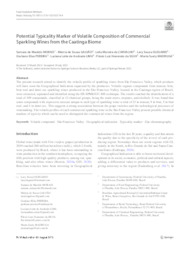Potential typicality marker of volatile composition of commercial sparkling wines from the caatinga biome.
Potential typicality marker of volatile composition of commercial sparkling wines from the caatinga biome.
Author(s): MORAIS, S. DE M.; GALVÃO, M. DE S.; CARVALHO, L. M. DE; OLEGARIO, O. S.; PEREIRA, G. E.; ANDRADE LIMA, L. L. DE; SILVA, F. L. H. DA; MADRUGA, M. S.
Summary: The present research aimed to identify the volatile profle of sparkling wines from São Francisco Valley, which products will have soon the Geographical Indication requested by the producers. Volatile organic compounds from muscat, brut, brut rosé and demi-sec sparkling wines produced in the São Francisco Valley, located in the Caatinga region of Brazil, were extracted, separated and identifed using the HS-SPME/GC?MS technique. The results reached the identifcation of a total of 109 compounds, classifed in 13 chemical groups, being the main esters, terpenes, and alcohols. It was found that some compounds with expressive area are unique to each type of sparkling wine: a total of 23 in muscat, 9 in brut, 5 in brut rosé, and 4 in demi-sec. This suggests a strong association between the grape varieties and the technological processes of winemaking. The volatile profles of each commercial sparkling wine in the São Francisco Valley present possible chemical markers of typicity which can be used to distinguish the commercial wines from the region. Keywords Volatile compound · São Francisco Valley · Geographical indication · Typicality marker · Gas chromatography
Publication year: 2022
Types of publication: Journal article
Unit: Embrapa Grape & Wine
Observation
Some of Embrapa's publications are published as ePub files. To read them, use or download one of the following free software options to your computer or mobile device. Android: Google Play Books; IOS: iBooks; Windows and Linux: Calibre.
Access other publications
Access the Agricultural Research Database (BDPA) to consult Embrapa's full library collection and records.
Visit Embrapa Bookstore to purchase books and other publications sold by Embrapa.

